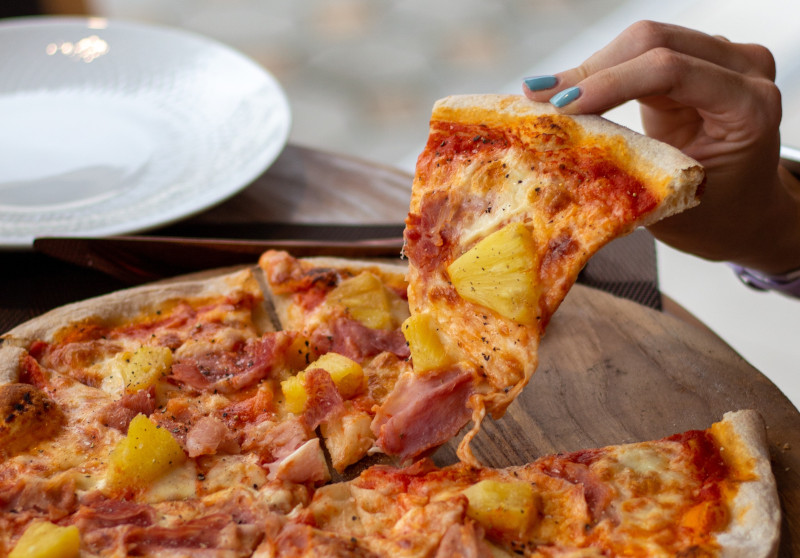Pizza toppings are a matter of personal preference, and one particular topping seems to spark questions like no other: whether and why pineapple belongs on pizza. The inclusion of pineapple on pizza, especially in the famous Hawaiian pizza, has divided pizza lovers around the world.
In this article, we will delve into the intriguing world of taste contrasts, flavor pairings, and the reasons why pineapple belongs on pizza, as well as explore the opposing arguments. So grab a slice and join us on this flavorful journey!
Taste Contrasts
One of the key ideas of food pairing is the concept of taste contrasts. The combination of sweet and salty flavors is a classic example that I find to be a lovely multisensory experience. When it comes to pizza, the marriage of the natural sweetness of pineapple with the saltiness of the cheese and sauce adds an unique twist to the traditional savory profile compared to your boring margerita. The contrasting flavors create a harmonious balance on the palate, providing a unique and enjoyable taste sensation.
Flavor – A Multisensory Experience
Flavor is not just about taste; it encompasses a multisensory experience that involves our sense of smell, sight, and even sometimes touch. The addition of pineapple to pizza adds a unique a burst of sweetness and also infuses the aroma of the tropical fruit into every bite of your ‘pie.
The vibrant color of the pineapple chunks adds visual appeal to the pizza, pairing nicely with the usual red base, making it even more enticing. Furthermore, the juicy texture of pineapple provides a delightful contrast to the chewiness of the crust and the creaminess of the cheese.
It’s this holistic experience that makes pineapple on pizza an intriguing choice for those who appreciate a culinary adventure. The science of salty and sweet is itself a field with a lot of depth. This article on the topic did a good job of helping me understand the concept and how chefs around the world use it to make delicious food.

Why is Pineapple on Pizza so Controversial?
The controversy surrounding pineapple on pizza stems from the clash of preferences and cultural differences. And also maybe part internet meme.
Pizza, originating from Italy, has evolved into various regional styles and toppings worldwide. While some pizza puritans argue that pineapple is an unconventional addition that doesn’t align with traditional Italian pizza flavors, others embrace the opportunity to explore new combinations and push culinary boundaries.
This clash of opinions has given rise to a lively and ongoing debate, sparking conversations and dividing pizza lovers into two passionate camps.
Who Invented Pineapple Pizza?
The origin of pineapple pizza, commonly known as Hawaiian pizza, is credited to the Greek-born Canadian culinary innovator Sam Panopoulos. In 1962, Panopoulos made food history by adding canned pineapple to a cheese and ham pizza at his Satellite Restaurant in Chatham, Ontario, Canada. It was an instant hit. In terms of influence, it probably ranks closely alongside the Caesar Salad.

Inspired by the fusion of sweet and savory flavors found in Asian dishes, Panopoulos introduced a new taste sensation that captivated his customers. Given the controversy it would later ignite, Panopoulos unknowingly set the stage for a debate that would span over six decades.
Why Pineapple Belongs on Pizza, Reasons For
The question of whether pineapple belongs on pizza is subjective and ultimately a matter of personal taste. While some vehemently oppose the combination, there are compelling reasons why pineapple finds its place atop (heh) this beloved Italian dish. Personally, it’s one of my favourite pizza flavor combinations.
- It Tastes Good: The natural sweetness of pineapple pairs harmoniously with the savory flavors of cheese and ham, creating a lovely flavor profile.
- It Adds a Burst of Freshness: Pineapple brings a refreshing and vibrant element to the pizza, enhancing the overall flavor profile.
- It Combines Well with Other Toppings: Beyond the classic Hawaiian pizza, pineapple can complement an array of toppings, such as bacon, sausage, and caramelized onions, expanding the realm of flavor options.
- It Offers Nutritional Benefits: Pizza isn’t known to be the healthiest of foods, but pineapple itself is packed with vitamins, minerals, and fiber, adding a healthy touch to an indulgent treat.
- It Sparks Creativity: Pineapple on pizza encourages culinary experimentation and the exploration of new flavor combinations, fostering a sense of culinary adventure.
Why Pineapple Might Not Belong on Pizza
Balance in all things, let’s look at some of the reasons that people claim pineapple does not belong on pizza.
- Traditionalist Arguments: Some argue that pizza should adhere to its Italian roots, and the addition of pineapple deviates too far from the traditional flavor profile.
- Textural Conflict: The juiciness of pineapple can create a contrast that some find unappealing when combined with the crust and cheese.
- Personal Preferences: Taste is subjective, and for those who simply do not enjoy the combination, pineapple on pizza will never find favor.
Some Final Thoughts on Pineapple and Pizza
The debate over pineapple on pizza is likely to persist, fueled by personal tastes and cultural differences. While the controversy may never be fully resolved, it is essential to respect individual preferences and celebrate the diversity of pizza toppings worldwide. Whether you belong to Team Pineapple or not, the joy of pizza lies in its ability to cater to a wide range of tastes and preferences. So, the next time you encounter a pineapple-topped pizza, embrace the opportunity to try something new and embark on a delightful culinary adventure.
After all, in the realm of pizza, there’s room for everyone’s unique flavors!


0 Comments